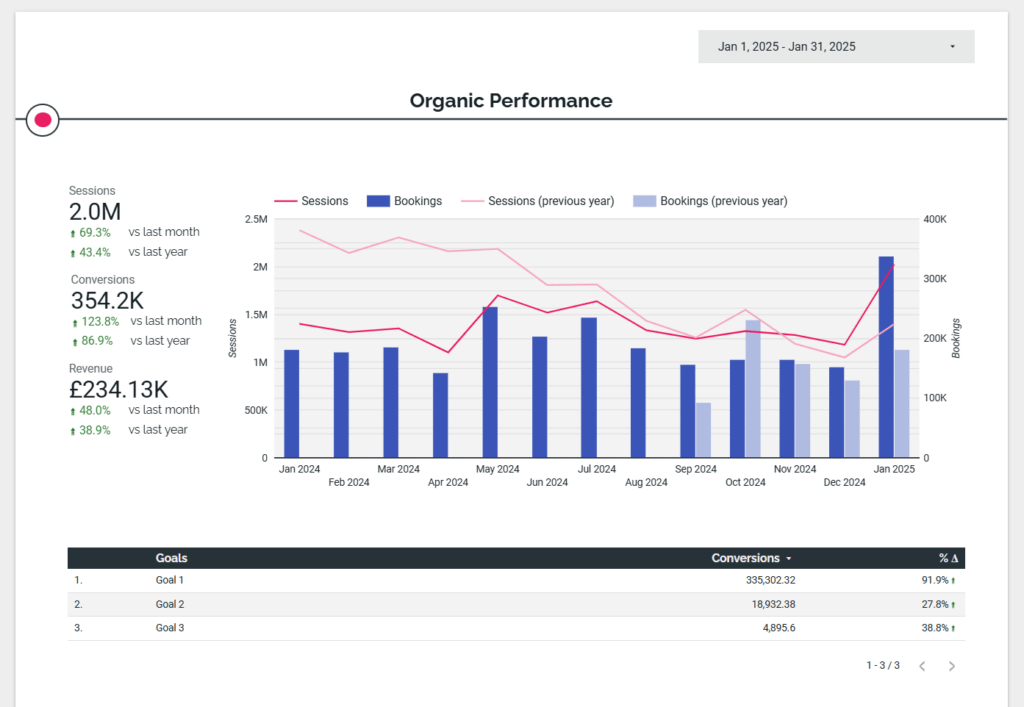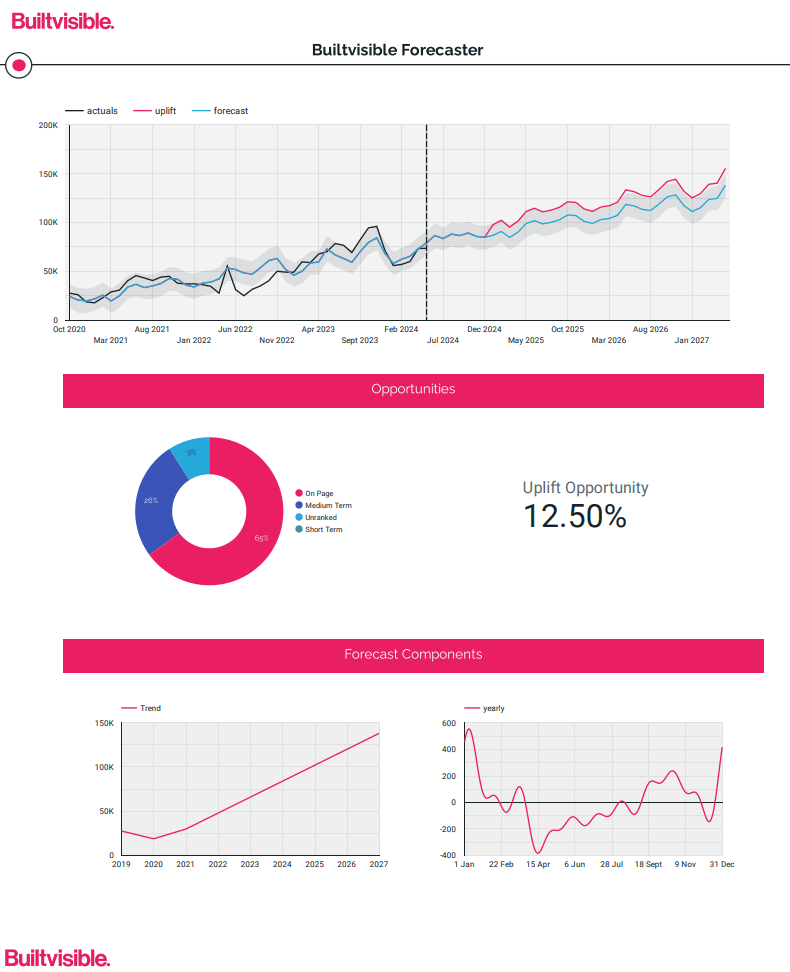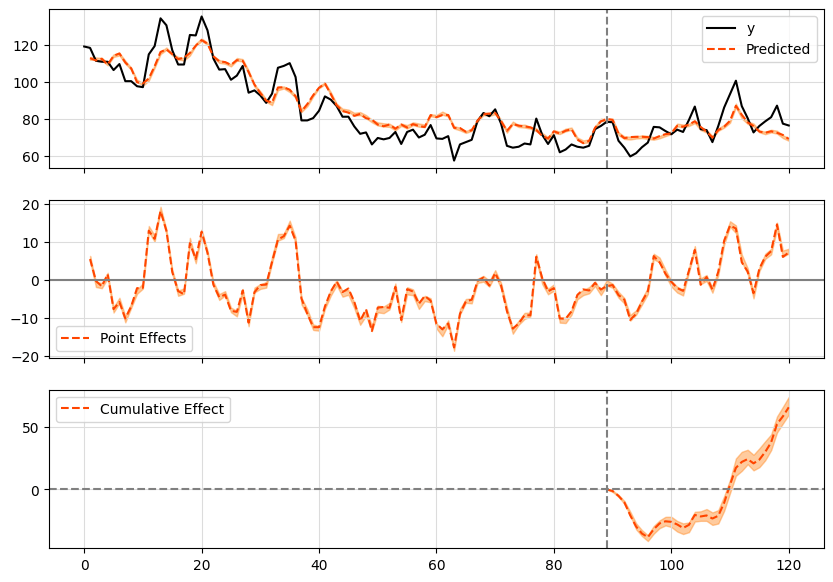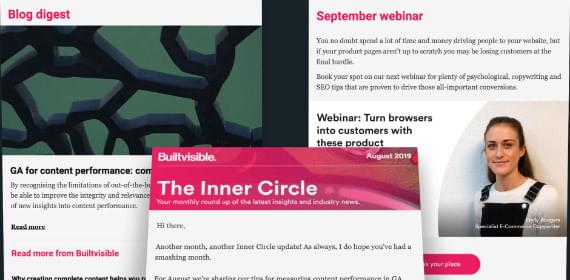Making Sense of SEO Performance Through Reporting
One of our core responsibilities is regular reporting. But we don’t just send over a list of numbers and call it a day. Our goal is to provide clear, meaningful insights that allow clients to understand what’s happening in their organic search performance and communicate these findings within their business.
Our reports highlight:
- Trends and patterns that might otherwise go unnoticed
- The impact of our SEO strategies on performance metrics
- Opportunities for improvement based on competitor analysis and industry trends

While reporting is a business-as-usual (BAU) activity, we’re constantly refining our approach. We integrate insights from forecasting models, causal analysis, and new SEO developments to make reports as insightful and actionable as possible.
Forecasting: Predicting the Future of Organic Search
One of the biggest questions clients ask us is, “Where is our organic search performance headed?” That’s where forecasting comes in.
Rather than relying on simple year-over-year comparisons, we take a data-driven approach to project future performance. Using Meta’s Prophet algorithm, we model trends with a high degree of accuracy, accounting for seasonality, external factors, and historical performance.
For clients looking to understand their growth potential, we overlay opportunity-sizing data onto our forecasts. This provides a much clearer picture of where they can realistically expect to land, allowing them to:
- Set realistic SEO goals
- Allocate resources efficiently
- Measure performance against data-backed benchmarks

Organic Testing & Causal Analysis: Proving What Works
Testing is a vital part of any data-driven strategy. Still, traditional A/B testing is complex in the world of SEO, because Google’s crawler doesn’t work like a user visiting two different versions of a page.
To overcome this, we use Google’s causal inference models. Instead of splitting traffic between two variations, we create a synthetic control group – a data-driven estimate of what would have happened without an SEO change. By comparing actual results against this control, we can isolate and measure the true impact of our optimisations.
This approach works particularly well for multi-market clients, as we can:
- Use similar content or products as control predictors
- Adjust for regional and seasonal factors
- Factor in external data, like weather, for travel brands
This methodology provides concrete evidence of what’s working, removing the guesswork from SEO decision-making.

In this image above, you can see the result of a causal test, which is broken down into three parts:
- The comparison of observed results (y) against the predicted results
- A plot of the difference between the two (point effects), and
- The cumulative effect over the duration of the test.
What this shows us is that we initially saw some small underperformance against the forecast, gaining momentum later in the test before resulting in a small win overall. This is a fairly common pattern for an SEO change, where it may take a while for Google to amend the SERP.
GA4 & GTM: Making Analytics Work for You
Our team has been working with Google Analytics and Google Tag Manager since day one, and we’ve helped countless clients set up, troubleshoot, and optimise their tracking setups so that they can better understand user journeys and more.
The shift to Google Analytics 4 (GA4) has been a significant industry change, and we were early adopters, starting back in the App+Web beta days. This means we’ve had years to refine our approach and understand the complexities of GA4, including:
- Event-based tracking and how it differs from Universal Analytics
- Data modelling and predictive analytics in GA4
- Ensuring accurate data collection despite new privacy regulations
Accurate tracking is the foundation of any SEO or marketing strategy, and we work hard to ensure clients get it right from the start.
“Working with Builtvisible’s analytics team has been a fantastic experience from day 1. We hired them to overhaul the ecommerce tracking across our bespoke checkout systems, a challenge which had caused numerous other agencies to run aground. From the initial analysis through to a hands-on collaboration with our teams, their work has been brilliant. It’s had a transformative impact on our ability to make decisions based on data.” – Steve Ward, Associate Director of Marketing, Sales and Digital, GLL
Read the full GLL data case study now.
Beyond SEO: AI, Data Warehouses & Marketing Mix Modelling
Not everything we do fits neatly into an SEO box. As AI adoption accelerates, companies need centralised, structured data to integrate with machine learning models and automation tools.
We use our expertise in data pipeline development to help clients build data warehouses, enabling them to:
- Unify SEO, PPC, and other marketing data
- Feed AI tools and custom models with clean, structured data
- Make faster, data-driven decisions
We’re also exploring Marketing Mix Modelling (MMM), an econometric approach to measuring the effectiveness of marketing channels. A vital tool in a world with increasing privacy restrictions.
Final Thoughts: More Than Just Numbers
Data is at the heart of everything we do, but our job isn’t just about crunching numbers. It’s about helping businesses make sense of them. Whether that means identifying new growth opportunities, forecasting future performance, or proving the impact of SEO, our goal is always to turn data into action.
At Builtvisible, we don’t just report on performance. We help shape it. Learn more about our data offering, or get in touch today to see how we can help your business make the most of data and drive commercial growth.
